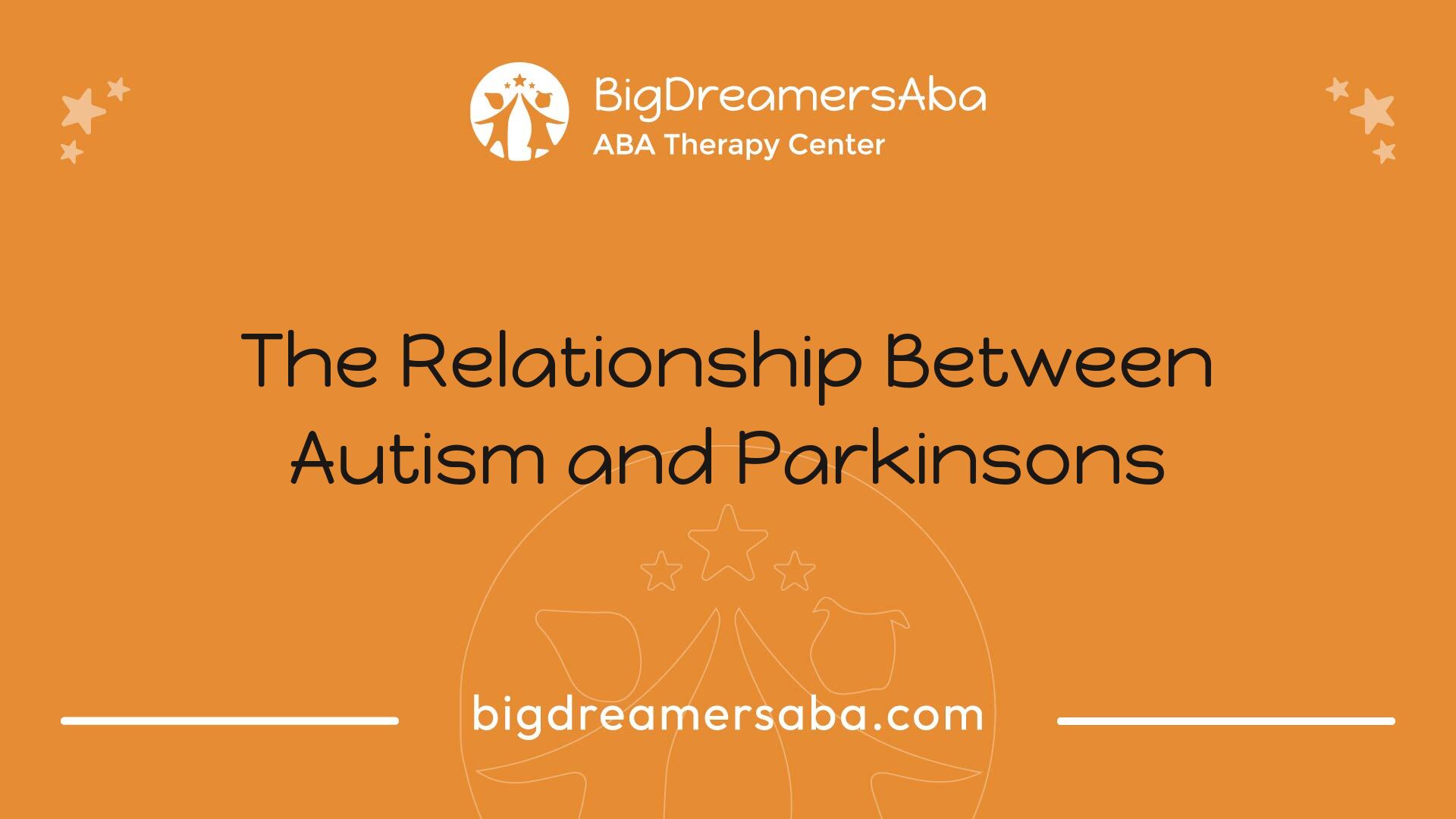The Relationship Between Autism and Parkinsons
Explore the intriguing link between autism and Parkinson's, uncovering shared symptoms and genetic insights.


Understanding Autism and Parkinson's
In exploring the relationship between autism and Parkinson's disease, it is crucial to understand both the similarities and differences that characterize these two conditions. This understanding lays the foundation for recognizing their potential overlaps, especially in genetic terms.
Similarities and Differences
Autism Spectrum Disorder (ASD) and Parkinson's disease share several characteristics, notably in terms of neurological function. Both conditions exhibit dysfunction in the basal ganglia and frontal lobe, areas of the brain that are crucial for motor control and cognitive functions. This similarity is also noted in individuals with Obsessive-Compulsive Disorder (OCD) as these regions are involved in behavioral regulation [1].
However, autism is typically identified in early childhood and presents with communication and social interaction challenges, alongside varying levels of sensory processing issues [2]. In contrast, Parkinson's disease generally manifests later in life, with notable motor symptoms such as tremors, rigidity, and bradykinesia.
CharacteristicAutism Spectrum DisorderParkinson's DiseaseAge of OnsetEarly childhoodMiddle to late adulthoodMotor SymptomsGenerally absentPresent (tremors, stiffness)Sensory ProcessingHeightened or reduced sensitivitySensory changes presentCognitive IssuesVaried (social and communication)Executive function challenges
Genetic Overlaps
Recent studies indicate genetic mutations are associated with both autism and Parkinson's disease, suggesting a complex link between the two. One of the identified genes is PTEN, implicated in both conditions. Such genetic factors play a significant role in the development of both ASD and Parkinson's disease and contribute to a high percentage of cases across populations [3].
Moreover, research shows that Parkinsonism appears to be more prevalent in adults with Autism Spectrum Disorders, reinforcing the idea of a possible intersection between these two conditions. Understanding these genetic overlaps provides crucial insight into the ongoing research aimed at uncovering potential therapeutic targets for both autism and Parkinson's.
In summary, both autism and Parkinson's share certain neurological features and genetic factors while displaying distinct symptoms and age of onset. This dual insight into their similarities and differences can help further research into their interconnectedness.
Link Between Autism and Parkinson's

Risk Factors and Prevalence
Research has indicated a notable relationship between autism spectrum disorder (ASD) and Parkinson's disease. Individuals with autism are 1.5 times more likely to develop Parkinson's compared to those without an autism diagnosis, as highlighted in a study published in JAMA Neurology. This significant association suggests that certain risk factors may overlap between the two conditions.
Other potential risk factors include age, as both disorders are often diagnosed in later stages of life. Genetic predisposition also plays a role in both conditions, as shared genetic factors may contribute to their development.
The following table summarizes the risk factors related to both autism and Parkinson's:
Risk FactorAutism Spectrum Disorder (ASD)Parkinson's DiseaseAgeDiagnosed early childhoodTypically later in lifeGenetic FactorsCongenital/genetic mutationsFamily history of PDNeurodevelopmental IssuesAbnormal brain developmentNeurodegeneration
Shared Biological Mechanisms
The biological pathways involved in autism and Parkinson's overlap in significant ways. Both conditions demonstrate alterations in brain functioning and complex neural networks. Dysregulation of dopamine—a crucial neurotransmitter—has been implicated in the symptoms of both autism and Parkinson's disease. For both groups, dopamine is associated with motor symptoms, cognitive challenges, and sensory processing issues.
Moreover, individuals with autism often exhibit sensory processing difficulties, manifesting as heightened or diminished responses to sensory stimuli such as touch and sound. In Parkinson's disease, similar sensory changes are noted, including altered perceptions of touch or smell.
A deeper insight into the shared biological mechanisms can be seen in the following table:
Biological MechanismsAutism Spectrum Disorder (ASD)Parkinson's DiseaseNeurotransmitter DysregulationDopamine alterationsImpaired dopamine productionMotor ControlStereotypical movements and coordination challengesTremors, bradykinesia, rigidityCognitive Processing ChallengesImpaired sensory integrationCognitive decline and executive dysfunction
The overlaps in both the risk factors and the biological mechanisms present a compelling area for future research into effective treatment strategies for individuals with either condition. Understanding these connections may also advance the knowledge around the pathophysiology and treatment of related disorders, such as obsessive-compulsive disorder.
Symptoms and Neurological Pathways

Understanding the symptoms and neurological pathways associated with both autism and Parkinson's disease reveals significant overlaps that merit attention. The challenges with motor control and cognitive functions provide insight into the relationship between these two conditions.
Motor Control Challenges
Individuals with autism may display various motor difficulties, including repetitive movements (stereotypies), unusual gait, and coordination issues. Meanwhile, Parkinson's disease is primarily recognized for its motor symptoms, such as tremors, bradykinesia (slowness of movement), rigidity, and postural instability [2].
Recent studies have highlighted the prevalence of bradykinesia in individuals with autism spectrum disorder (ASD). The rates of bradykinesia were found to be 50.0% in children (ages 6-12 years) and a higher 65.2% in adolescents (ages 13-26 years). Although tremors were noted, their occurrence did not significantly differ across age groups, while rigidity was more commonly reported in older adolescents.
Motor Control ChallengeAutism (Children)Autism (Adolescents)Parkinson's DiseaseBradykinesia50.0%65.2%CommonRigidityLess frequentMore frequentCommonTremorsNot significantly differentNot significantly differentCommon
Cognitive and Sensory Issues
Both autism and Parkinson's disease can result in a range of cognitive and sensory challenges. Individuals with autism often encounter difficulties in social interaction, communication, and exhibit restrictive or repetitive behaviors. Additionally, they may struggle with executive functions, which include planning, organizing, and problem-solving.
In contrast, cognitive symptoms associated with Parkinson's often involve issues related to memory, attention, and executive functions. The overlap between these functions in both conditions suggests a commonality in the neurological pathways involved. For example, patients with Rett syndrome, a disorder closely linked with autism, frequently display parkinsonian features such as bradykinesia and rigidity, highlighting a shared neurological underpinning [4].
The interplay of motor control and cognitive functions in autism and Parkinson's disease invites further research into their connections and potential therapeutic avenues. Understanding these aspects may support better interventions aimed at addressing these symptoms in affected individuals.
Genetic Influences
Mutations and Associations
Research indicates that certain genetic mutations play a significant role in the relationship between autism and Parkinson's disease. For instance, mutations in the PTEN gene have been connected to both conditions, highlighting overlapping genetic risk factors [5]. Moreover, variations in the PARK2 gene are found more frequently in individuals with autism spectrum disorder (ASD) compared to those without. Other genes associated with both ASD and Parkinson's include RIT2 and CD157/BST1.
The following table summarizes key genetic associations:
GeneAssociation with AutismAssociation with Parkinson'sPTENYesYesPARK2YesYesRIT2YesYesCD157/BST1YesYesDRD2UnclearYesGPCR37UnclearYesSLC gene familyUnclearYesSMPD1UnclearYes
This table illustrates the varying levels of evidence supporting the involvement of these genes in autism and Parkinson's disease. The connections highlight a complex interplay between genetic factors in both conditions.
Potential Therapeutic Targets
Understanding genetic influences not only aids in grasping the connections between autism and Parkinson's but also opens avenues for potential therapeutic targets. For instance, therapies aimed at modulating the effects of mutations in the PARK2 gene or targeting the pathways involving RIT2 and CD157/BST1 may be developed to address both autistic and Parkinsonian symptoms.
Current research is exploring how genetic insights can lead to more personalized treatment approaches. This may include developing specific medications or intervention strategies based on an individual’s genetic profile. Continued studies on these shared genetic mutations may yield valuable insights for treatments. Research focusing on the pathways impacted by these genes could provide crucial information for creating effective therapies that address both conditions concurrently.
For those interested in learning more about the relationship and implications of these findings, additional resources about autism and seizures and other related conditions can offer further context.
Research Findings
Exploring the link between autism and Parkinson's reveals important insights from clinical studies and advancements in brain imaging technology. These findings help deepen understanding of the relationship between these two conditions.
Clinical Studies
Recent clinical studies have demonstrated a notable prevalence of Parkinsonism among individuals with Autism Spectrum Disorders (ASD) compared to non-ASD individuals. Research indicates that Parkinson's disease is significantly more common in both younger and older adults with ASD, suggesting an increased susceptibility to parkinsonism in this population.
A summary of key findings from clinical studies is presented in the table below:
Study FocusFindingsPrevalence RateParkinsonism in ASDIncreased prevalence of Parkinson's disease in adults with ASDHigher than non-ASD controlsRett SyndromeParkinsonian features: bradykinesia, rigidity40% to 80% prevalenceGenetic MutationsRare mutations in specific genes (e.g., ATP13A2, CLN3)Associated with autistic behavior and parkinsonism
Another important finding indicates that certain genetic mutations, such as those in genes ATP13A2, CLN3, and WDR45, are linked to both autistic behavior and parkinsonian features. Clinical assessments showed that patients with these mutations exhibited varying responses to Levodopa therapy, highlighting the complexity of treatment options.
Brain Imaging Technology Insights
Advancements in brain imaging technology have provided further insights into the neurological underpinnings of autism and Parkinson's. Imaging studies allow researchers to identify brain structure and activity patterns that may differentiate individuals with ASD from those with Parkinson's disease.
Using techniques such as functional Magnetic Resonance Imaging (fMRI) and Positron Emission Tomography (PET), researchers have been able to observe significant differences in brain connectivity and activation. These differences may play a role in understanding shared neurological pathways between the two conditions.
Furthermore, the identification of copy number variations in genes such as PARK2, which exhibit higher frequencies in ASD cases, provides a promising area for future research. Other genes implicated in both conditions, including RIT2 and CD157/BST1, may point to shared biological mechanisms that warrant further exploration.
Overall, findings from clinical studies and brain imaging technologies offer valuable perspectives on the intricate relationship between autism and Parkinson's, paving the way for potential therapeutic targets and interventions that could benefit individuals facing both conditions.
References
[2]:
[3]:
[4]:
[5]:
Recent articles
.jpg)
Autism Services for Kids in Maryland

In-Home Support Services for Autism
